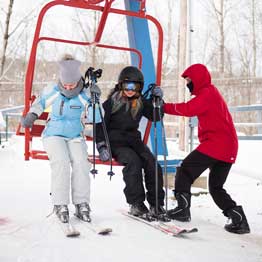Working on the slopes at a ski resort is one of the most thrilling and satisfying jobs you can earn. If you are lucky enough to land one of these sought-after positions as an instructor, patroller, host, or operator, then you have more on the line when it comes to getting injured.
Blowing out the ligaments in your knee, tearing your rotator cuff in your shoulder, or throwing out your back can be devastating to your ability to do your job. Take precautions to reduce your chance of ending up at a desk when you really want to be out on the snow, doing what you love.
Here are 7 simple tips for protecting yourself and your career…
1. Reduce Surprises
Take the time to get to know your mountain and the terrain. The more you can predict, the less you have to react. Injuries are less likely to happen when you are anticipating a movement, not relying on reaction time, where there is naturally very little room for error. When you know what is ahead, you will be more controlled and less likely to get hurt.
2. Know the Most Common Ways You Can Get Hurt
Knees are the most commonly injured body part for skiers, usually from a twisting fall and leverage from the ski. If you are in a dangerous position to begin with, you’ll be more likely to suffer a severe ligament injury, like a torn ACL, if you encounter a twist at the knee.
Shoulders and wrists are the most common injury for snowboarders, often from falling onto an outstretched arm. Tuck those arms in close to your body if you are going down!
Lifting more than you can handle, or with a rounded shoulder, is also a common cause of shoulder problems. So either strengthen up, get your shoulder blade set back in good posture, or don’t lift as much.
50% of Americans suffer from lower back pain at some point in their life, which shows how common lower back problems are. You can injure your back by combining a lift and twist, or simply from poor posture over time. Know how to use good lifting mechanics, even if what you are lifting is as light as a feather.
💡 We know which injuries are most common. We know that certain movement patterns or positions typically cause these injuries.
👉 Be self-aware to reduce your chances of getting hurt.
3. Take Calculated Risks
It should not come as a surprise that those who choose to work outdoors in winter conditions, and who have excelled to a level of becoming a professional on the slopes, might naturally be higher risk-takers. With higher risk behavior and more exposure, comes more injury potential. The difference between paying a consequence for your risk, or basking in the adrenaline, might be when and among which variables you choose to take that risk.
Instead of saying NEVER push your speed or limits, how about you quickly assess the situation and weigh the consequences…or the risk to benefit ratio.
On the mountain, conditions are always changing. Consider snow conditions, weather pattern, crowds, etc. Be smart about when you take a bigger risk. Know when to be more conservative and protective of yourself and others. Know when the risk is relatively low and it’s safe to push yourself. You can have the freedom and excitement to live the life you want, without landing yourself in the emergency room. It’s all about Risk vs. Reward.
4. Be Careful with Repetitive Movements
If your job requires pushing, pulling, lifting, or bending over and over, make sure you do these movements correctly. Stay in your mid-range with your core muscles engaged. Try not to let your arm go all the way behind you to an extreme. Try not to round your back forward and then lift with all your might. Stay close to neutral and use physics to your advantage so you avoid putting extra stress on your muscles, tendons, ligaments, and joints. A rotator cuff tear or herniated disc can happen with one wrong lift or reach…and it could take 6-12 months to get back to normal.

5. Stay Hydrated and Fueled
Dehydration and low blood sugar lead to delayed cognitive processing and decision-making. When you’re working outdoors for hours at a time, where quick, accurate decision-making is critical, you cannot afford to let your brain or body fatigue. That is when accidents happen. Drink water frequently throughout the day, without waiting until you are parched. Have nutritious snacks accessible to fuel your body in between meals. The goal is to avoid extreme drops and spikes in your blood sugar, which will keep you more focused, attentive, and successful with your tasks.
6. Use the Right Equipment
Use equipment that fits properly, meets safety standards, matches the conditions, and helps you feel confident on the slopes. Fear and inhibition can be just as dangerous as being overly-aggressive. The best equipment for you might be different than someone else. Make good, professional decisions about what will promote a successful, productive, safe day on the job for YOU.
7. Be Strong. Be Balanced. Be Ready.
Engaging the right muscles, the right way, is the difference between wasting time and getting real results when you exercise. Focus on the 5 Pillars for Performance and Injury Prevention.
At ACL Strong, we focus on improving these 5 areas over 2-3 months to make the biggest impact in the least amount of time.
1) Strengthening for the legs, hips, and core
2) Balance training
3) Reinforcing better movement patterns
4) Improving reaction time
5) Increasing flexibility and mobility
A good exercise progression with neuromuscular training, like we emphasize in ACL Strong can get you up to speed in all 5 areas to help you become more resilient for a successful, healthy season and longer career.
To see our complete framework for having an injury-free season, start with our e-book, Getting In Shape For Ski Season, and when you’re ready to work with us to become more resilient and durable for a long life of action, activities, and fun, join the ACL Strong Signature Program.



